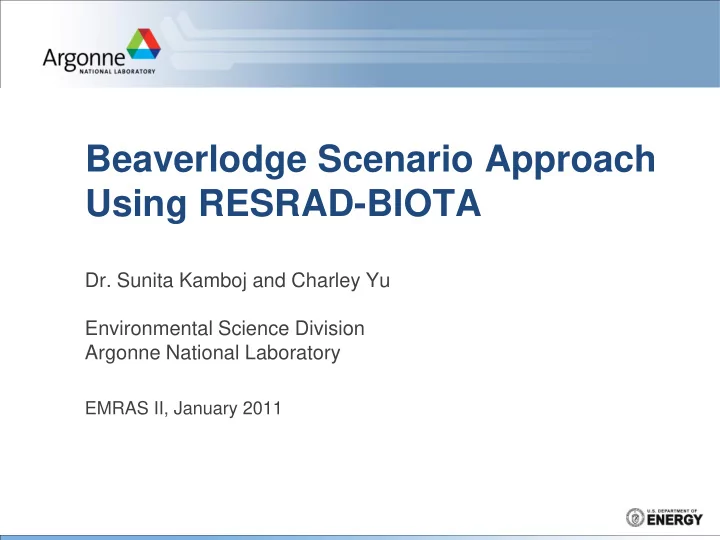

Beaverlodge Scenario Approach Using RESRAD-BIOTA Dr. Sunita Kamboj and Charley Yu Environmental Science Division Argonne National Laboratory EMRAS II, January 2011
Beaver Lodge Exercise Phase II Provided water or/and sediment concentrations for five radionuclides (Pb- 210, Po-210, Ra-226, Th-230, and U-238). Measured activity concentration for fish species provided in some cases The samples were collected from 1995 – 2008 at 6 areas at 15 sites Six areas are: – Beaver lodge Lake – Cluff Lake – Gunnar Mine Site – Key Lake – McClean Lake – Rabbit Lake Calculate whole body activity concentration and weighted absorbed dose rates for fish and invertebrates. 2
Methodology and Assumptions • Used Probabilistic RESRAD-BIOTA • Used distributions for water concentration, sediment concentration, and tissue concentrations (if available) • If water or sediment concentration not available used conservative Kd values to estimate activity concentrations • Used probabilistic Biv values 3
Input Parameters for Model Run DOSIMETRY - Weighting factors for absorbed dose rates to be consistent with other Internal alpha 1.00E+01 models Internal beta gamma 1.00E+00 Internal low beta 1.00E+00 DOSIMETRY - Daughters explicitly included Po-210 Pb210 Bi-210 (100%) (100%) Po210 X X X X X Pb-214 & Po- Ra226 Rn-222 Po-218 Bi-214 214 At-218 & Tl-210 Th230 U-238 Th-234 Pa-234 Pa-234m U-235 Th-231 U-234 It was assumed U-238, U-234 and U-235 were present in their natural activity concentration ratio of 1:1:0.046. Pb-210: Bi-210 and Po-210 was assumed to be in secular equilibrium with Pb-210. Ra-226: Rn-222, Po-218, Bi-214 at the same conc. as Ra-226, Bi-214 and Po-214 at 99.98% of Ra-226 conc. And At-218 and Tl-210 at 0.02% of Ra-226 conc. U-238: Th-234 at the same concentration as U-238, Pa-234m at 99.8% and Pa-234 at 0.33% of U-238 concentration. U-235: At 4.6% of U-238 concentration. Th-231 at the same concentration as U-235 U-234: At the same concentration as U-238 4
Input Parameters for Model Run, cont’d GEOMETRY, MASS, & OCCUPANCY FACTORS Occupancy- Mass (g Biota run Geometry (cm) ww) % water / Length x Geometry - %sediment height x width used Pelagic (e.g. Northern pike & Lake Trout) 50 x 15 x 10 1200 87.5/12.5 4 Benthic Fish - Large (White sucker & Lake whitefish) 45 x 15 x 10 1191 65/35 4 Benthic Fish - Small (Lake chub) 6.8 x 1.5 x 1 4.5 90/10 Ext -2 and Int -3 Benthic Invertebrates 0.34 x 0.17 x (Chironomus riparius) 0.15 0.12 62.5/37.5 1 Benthic Invertebrates ( Pisidium sp. ) 2.5 x 1.5 x 1 1.6 75/25 2 Benthic Invertebrates (Caddisfly, Nemotaulius sp. ) 3.5x1.46x1.46 1.75 75/25 2 5
Assumptions for Model Run Species Biv - used Pb-210 Po-210 Ra-226 Th-230 Uranium Pelagic (e.g. Northern pike Bounded Bounded Bounded & Lake Trout) Pelagic fish Exponential Exponential Lognormal Lognormal Lognormal Benthic Fish - Large (White Bonded Bounded Bounded sucker & Lake whitefish) Benthic fish Exponential Exponential Lognormal Lognormal Lognormal Benthic Fish - Small (Lake Bonded Bounded Bounded chub) Benthic fish Exponential Exponential Lognormal Lognormal Lognormal Benthic Invertebrates (Chironomus riparius) Insect Larvae Exponential Exponential Exponential Exponential Exponential Benthic Invertebrates Bivalve Bounded Bonded ( Pisidium sp. ) Mollusc Exponential Lognormal Lognormal Exponential Exponential Benthic Invertebrates (Caddisfly, Nemotaulius sp. ) Insect Larvae Exponential Exponential Exponential Exponential Exponential *For exponential distribution parameter required is lambda (=1/mean) and for bounded lognormal distribution parameter required are mean, error factor, minimum, and maximum 6
RESRAD-BIOTA Inputs for Contamination at Beaverlodge Lake RBE and cutoff half-life adjusted Sediment concentration calculated from Occupancy factors for water and sediment Maximum Pb-210 Kd in Beaverlodge lake area
Uncertainty Analysis Setup in the RESRAD-BIOTA Code
Recommend
More recommend